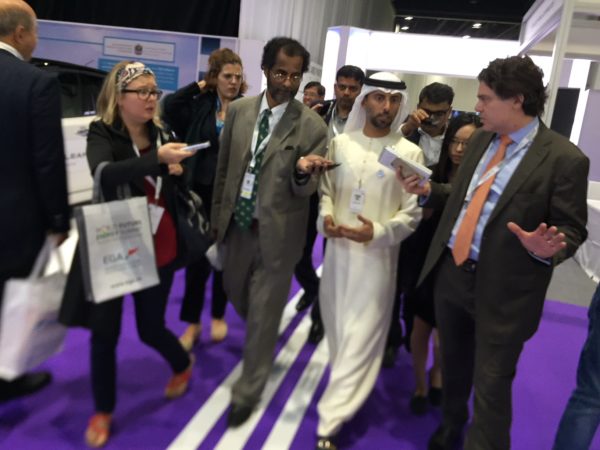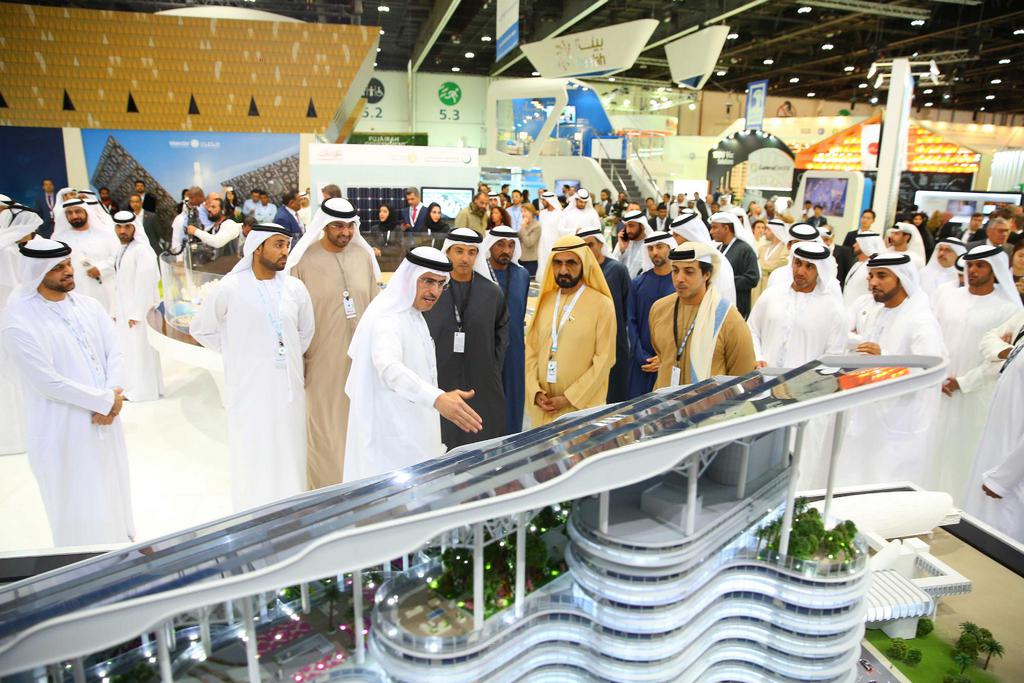1. It’s game on for utility scale PV
There is absolutely no doubt that the Middle East and wider MENA region are emerging as solar markets of considerable consequence. And while there are numerous drivers, including nations implementing measures to meet their Paris climate commitments, they are primarily economic.
Large scale solar is not only competitive but it has now become a compelling proposition for governments and utilities in the region. Discussions as to some of the low power purchase agreements (PPAs) being achieved by PV power plants in the region took center stage at this year’s WFES.
Solar PPA records started to tumble in the region in 2016. During that year, US$2.99 cents/kWh was achieved for the 800 MW Phase III of the eventual 5 GW Mohammed bin Rashid Al Maktoum Solar Park (MbR) project currently taking shape outside of Dubai, Abu Dhabi’s 1 GW Sweihan mega-array came in at US$2.42 cents/kWh, while the 170 MW Noor IV in Morocco hit US$4.6 cents.
2017 saw an acceleration of this trend. Saudi Arabia’s 300 MW Sakaka project attracted bids of US$1.786 cents/kWh from Masdar, US$2.341 cents/kWh from ACWA Power, and US$2.660/kWh from Marubeni.
Egypt also revised down its tariff for Round II of its Benban Solar Park from US$14.34 to US$8.4 cents/kWh. Once complete, Benban will have a cumulative capacity of 490 MW, comprised of smaller sub-projects, sized at roughly 50 MW and 20 MW each.

Image: pv magazine/Jonathan Gifford
There are nuances to some of the headline tender prices, such as peak and seasonal variations, which mean that in reality, final total PPA prices may be higher.
Free or subsidized land and grid connection for projects in some cases is also a factor.
Nonetheless, the headline figures speak to solar’s attractiveness for electricity generation in many parts of the Middle East, and has piqued the interest of policy makers and utilities alike.
Underpinning some of this extremely competitive pricing is the availability of cheap finance, notes the Middle East Solar Industry Association’s (MESIA) Marketing & Communication Director, Gurmeet Kaur. Indeed, the quality of the off-takers for many of these large tenders, predominately government-owned utilities, significantly reduces the projects’ financial risk, attracting low-cost Asian and European capital and financiers.
2. Building an industry
While suppliers from across the solar globe attended WFES, and the Solar Expo in particular, players from the region are playing an increasingly prominent role. In fact, policymakers in the region appear to be making the development of a domestic renewables industry a priority. While oil and gas continue to be the primary source of revenue across the Gulf States, renewables, and particularly solar PV, are seen as industries of the future.
PV module manufacturing is an industry that Saudi Arabia is looking to develop. Under its Vision 2030 program, it is restructuring its electricity market and allowing the participation of private companies and investors, as is evidenced in the independent power producer (IPP) nature of the Sakaka development in the north of the country – rather than it being wholly or partially state owned.
Saudi Arabia’s solar program has also set domestic content provisions, which target 30% local content for projects awarded in 2017, with this stepping up to 40-60% this year, and 60% from 2019.
Speaking during WFES, Turki Mohammed Al Shehri, head of the Kingdom’s Renewable Energy Project Development Office (Repdo) acknowledged that the interests of domestic content and the lowest cost projects may not always coalesce – resulting in a trade off his office appears willing to make.
Relatively small-scale PV production is already underway in the UAE, with Maysun Solar beginning commercial production this month. Maysun has an annual module assembly capacity of 40 MW and aims to increase that output to 200 MW over the next three years. The company has gained a range of relevant certifications, including with the Dubai Electricity and Water Authority. It is located in Dubai’s Jebel Ali Free Zone's (Jafza)
Given the growing interest in module production in the region, albeit at an early stage, some PV production equipment suppliers were present at WFES. Both Manz and Solibro exhibited at the event, and pointed to advantage that a fully integrated thin film module line can present. They also highlighted the favorable temperature coefficient that thin film, and CIGS in particular, can achieve.
With a glass in, module out production process, thin film equipment suppliers hope that industrial players in the region will favor the technology over the multi-stage ingot, wafer, cell and module crystalline silicon manufacture. Design elements, such as symmetrical oriental designs, can also be on monolithically deposition thin film modules and was showcased by Manz at its booth.
3. Next stage distributed
With utility scale development well underway, rooftop PV in the Gulf States is the next market segment being developed by policy makers. MESIA communications head, Kaur describes distributed PV as representing the ‘next stage’ of development for solar in the Middle East – likely to take root at large scale in 2019.
However, notable projects and policy moves are already underway. In 2016, logistics giant commenced work on its rough 25 MW multi-roof project at Dubai’s Mina Rashid Port and its Jafza facilities.
Dubai utility, DEWA, which is behind the massive MbR utility scale solar project, has also launched its ‘Shams’ initiative, allowing rooftop PV and feed into its grid in the city state.
Smaller gulf states are also turning to rooftops. Abdul Hussain Ali Mirza, the Minister of Electricity and Water Affairs, Kingdom of Bahrain, noted that while the nation only has modest renewable energy targets, it has undertaken fundamental reforms to foster PV. Bahrain targets only 5% renewables by 2020, stepping up to 10% by 2030.
Only two weeks before WFES opened its doors, Bahrain approved a net metering program for rooftop PV. Al Mirza noted that this was effectively breaking the monopoly for electricity supply in the country for the first time.
Banhrain has also carried out a survey of all of its schools, hospitals and government buildings, to ascertain how much solar can be added on these buildings. “We are going to put solar on all of these,” he said. Shortly after, the Kingdom’s Energy Minister summed up the fundamental driver behind the energy gripping the solar sector in MENA at present in no uncertain terms.
“Bahrain was the first country to discover oil in 1932, but it is going down and we are going to need new energy,” he said.
Beyond the big three
While these discrete trends were perhaps the most pervasive during the 2018 WFES, there were a host of other talking points of note. The focus on youth throughout the event left attendees in no doubt of the impetus renewable energy and solar are being given to the regional leaders of tomorrow. E-mobility, too had a strong presence, and with the car still dominant among the Gulf States, linking it with clean electricity will be important going forward.
The role of Masdar, underpinned by the Abu Dhabi sovereign wealth fund vehicle, the Mubadala Investment Co., is beginning to crystallize. Announcements as to Masdar’s renewable development activities and research collaborations on a global basis were released with metronome-like regularity over the four days.
Mubadala Investment’s Chief Communications Officer, Brian Loft spoke at the Abu Dhabi Sustainability Week glitzy opening ceremony and he encouraged attendees to be mindful of the Butterfly Effect – where small actions can have major reverberations in years to come.
But it was Director General of the Abu-Dhabi headquartered, International Renewable Energy Agency, Adnan Z. Amin who perhaps most aptly captured the mood over the four days in Abu Dhabi. Seated alongside the UAE’s Energy Minister Suhail Al Mazroui, he spoke to the importance of grid interconnection among the countries of the region, and how it will be essential in enabling trading and bringing down the cost of investment.
“Optimism is in the air,” said Amin. “It is truly remarkable the things that we are seeing. There are trends developing at a local level that are potentially transformative.”
This content is protected by copyright and may not be reused. If you want to cooperate with us and would like to reuse some of our content, please contact: editors@pv-magazine.com.




1 comment
By submitting this form you agree to pv magazine using your data for the purposes of publishing your comment.
Your personal data will only be disclosed or otherwise transmitted to third parties for the purposes of spam filtering or if this is necessary for technical maintenance of the website. Any other transfer to third parties will not take place unless this is justified on the basis of applicable data protection regulations or if pv magazine is legally obliged to do so.
You may revoke this consent at any time with effect for the future, in which case your personal data will be deleted immediately. Otherwise, your data will be deleted if pv magazine has processed your request or the purpose of data storage is fulfilled.
Further information on data privacy can be found in our Data Protection Policy.